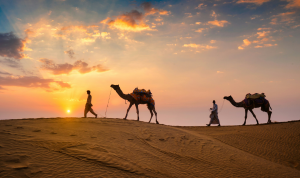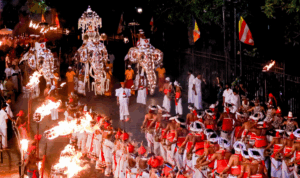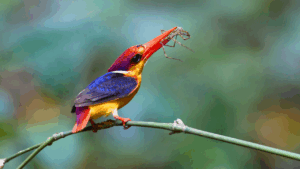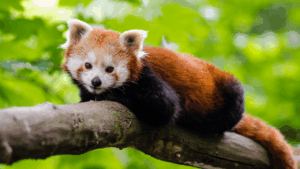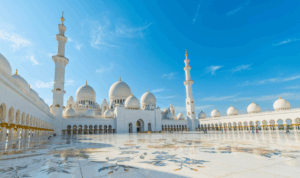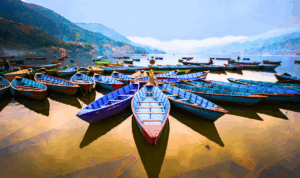From the Gulf to the Himalayas, from tropical forests to desert canyons, the turn of the year takes many forms. Some places welcome midnight with fireworks over modern skylines; others mark it quietly, with river mist, morning chants, or the sound of animals moving through tall grass.
This guide explores four ways to enter the new year across Asia and the Middle East — through celebration, wilderness, stillness, and solitude. Each destination offers a different way of paying attention.
The Party Scene: Where Cities Mark the Moment
Dubai, UAE – A City Built for the Spectacle 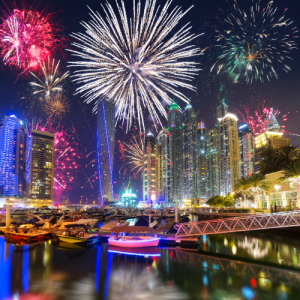
Dubai’s skyline is built with visibility in mind. The city stretches along the Gulf in a long, deliberate line, with towers spaced to reflect light and catch the eye from far offshore. On New Year’s Eve, this design becomes part of the experience. The waterfront districts — Marina, JBR, Bluewaters, the Palm islands, and the Creek — each host their own displays, creating a sequence of fireworks that travel along the coast in timed bursts. From the right vantage point, you can watch multiple shows unfolding at once, each framed by water and high-rise silhouettes.
Crowds tend to gather around the Burj Khalifa, but the city’s broader geography offers many ways to experience the night without being inside the main crush. Elevated roads, wide promenades, and beachfront walkways turn into informal viewing points. The mix of locals, longtime residents, and travellers gives the night a communal feel, even in a city known for its scale.
Just beyond the city limits, the landscape changes sharply. Within minutes, the glass towers give way to open desert — flat, quiet terrain that has shaped the region for centuries. At night, the air cools, and the horizon becomes a clean line against the sky. It’s a perspective that makes the city feel distant, almost weightless. Many visitors combine the two experiences: the spectacle at midnight and the desert’s stillness later in the night. Together, they explain why Dubai feels both futuristic and rooted in its environment.
Planning Tips
- Book your viewing experience early, but look beyond Downtown — waterfront districts like the Marina, JBR, and the Creek offer excellent fireworks without the intensity of Burj Khalifa crowds.
- Pick one setting for the night — a rooftop, a beach club, or a desert camp. Dubai is best experienced when you commit to a single atmosphere rather than trying to move between areas.
- Arrive before sunset if you’re staying in the city; watching the skyline shift light over the Gulf adds depth to the evening.
- If you want multiple fireworks, choose coastal spots such as Bluewaters or Palm West Beach, where displays unfold along the shoreline.
- Balance the night with contrast — pair the city’s energy with a late-night drive into the desert if you want a quiet ending.
Muscat, Oman – A Coastline Shaped by Calm 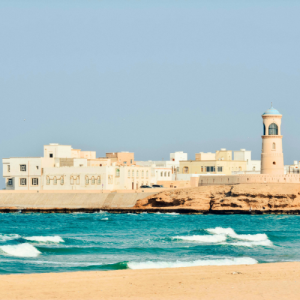
Muscat faces the Gulf of Oman in a long curve, with neighbourhoods arranged between rocky hills and the sea. Unlike many regional capitals, the city has kept a low skyline; its whitewashed buildings and coastal roads follow the natural contours of the land. This geography shapes the atmosphere on New Year’s Eve as much as the celebration itself.
As evening settles, the corniche in Muttrah becomes a focal point. Lanterns illuminate the waterfront, and families stroll along the promenade, stopping for coffee or to watch dhows moving in and out of the harbour. The pace is steady and unhurried — gatherings feel local, not staged for visitors. Beachside lounges begin to fill, often with a blend of Arabic house music and live instrumental sets that reflect the city’s mix of tradition and modernity.
Fireworks are launched from several points along the coast, and the wide, open shoreline turns them into long reflections across the water. Instead of one central countdown, the city experiences several smaller moments spread across different districts. These displays are seen as much from quiet stretches of sand as from hotel terraces, and travellers often find that some of the best views come from informal spots along the coast rather than designated viewing areas.
What stands out most is how Muscat maintains its character even on a night of celebration. The mountains remain dark outlines behind the city, the sea stays central to the evening, and the social atmosphere is relaxed. It’s a destination where the new year is marked not by intensity but by steady, shared presence — a coastal city observing its own rhythm while welcoming the next day.
Planning Tips
- Let the coastline shape your night — choose venues that open directly to the water rather than enclosed indoor spaces.
- Arrive earlier than you think — Muscat moves at an easier pace, and the experience improves when you settle in before nightlife picks up.
- Seek out venues with cultural elements — small bands, Arabic house, or live percussion connect you to Muscat’s character.
- Use the quieter environment to your advantage — pick viewing spots where you can hear the sea as well as see the fireworks.
- Plan a relaxed New Year’s Day — Muscat’s mornings are slow; a walk along the corniche or a visit to a local café offers an easy, restorative start.
Mumbai, India – New Year in the City of Dreams 
Mumbai stretches along a long arc of coastline, and most New Year’s celebrations follow that curve. Late in the afternoon, people head toward Marine Drive — a 3-kilometre promenade known locally as the “Queen’s Necklace” for the way its lights form a gentle arc along the bay. By dusk, the seawall becomes one of the city’s most inclusive gathering places. Travellers sit beside locals, watching small fishing boats return as the last ferries cross the harbour.
As the evening builds, different parts of the city take on their own character. In Colaba, cafés and historic hotels host live music, drawing both residents and visitors. Nearby, the Gateway of India faces the harbour, where private boats offer slow cruises under the open sky — a quieter way to watch the night unfold.
The transition from night to morning is one of Mumbai’s defining experiences. As late-night venues wind down, early-morning routines begin almost immediately. Fishermen set out from small jetties, fruit sellers push carts toward markets, and Marine Drive fills once again — this time with joggers and walkers greeting the first sunrise of the year. For travellers, it’s a rare moment to see the city’s rhythm reset in real time.
Planning Tips
- Choose a single neighbourhood for the night — Mumbai’s New Year’s Eve works best when you avoid long cross-city drives. Pick the harbourfront for views or central rooftops for music-focused events.
- Start your evening by the sea — a walk along Marine Drive or a quiet moment at the harbour sets the tone and helps you adjust to the night’s pace.
- Opt for venues with curated music — Mumbai’s strength lies in its independent music scene; look for live jazz, indie sets, or well-produced DJ nights over generic commercial events.
- Book early if you want a rooftop sunset — these are the first to fill and offer the best experience without crowds.
- Keep your post-midnight plan simple — late-night cafés and coastal drives are often more enjoyable than switching venues after 12.
Delhi, India – A City of Contrasts 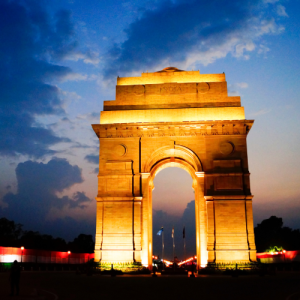
New Year’s Eve in Delhi is driven by its nightlife, and the best experiences come from choosing the right pace. Many travellers begin their night in upscale lounges known for solid cocktail programmes and a well-dressed crowd. These early hours are slower and more social — a chance to settle in before the city shifts gears.
As the evening builds, Delhi’s high-end clubs take over. The nightlife here is polished and production-heavy: guest DJs, themed nights, long electronic sets, and dance floors that stay busy well past midnight. Venues put effort into lighting, sound, and atmosphere, and most operate on advance reservations or table service for the night. The crowd arrives late, and the energy is confident and upbeat.
For those who prefer something quieter, several luxury hotels host smaller celebrations built around dining, live music, and attentive service. These offer a calmer way to mark the countdown without stepping into a crowded club — ideal for travellers who want a refined night rather than a high-volume one.
Fireworks appear in scattered bursts across the skyline, usually visible from rooftop bars or open-air terraces attached to clubs. There is no central show, which allows you to stay in one place without missing anything. The mood after midnight shifts naturally — music softens, conversations take over, and the pace slows into the early hours.
The next day unfolds more slowly. Many late-night venues switch to relaxed brunch service, and travellers often use the morning to reset with good coffee and a quiet meal. Shops open later, making the day ideal for browsing bookstores, boutiques, and contemporary craft shops without the usual rush. By afternoon, the city eases back into its routine, but the softer pace lingers long enough for visitors to see Delhi in a calmer light — a welcome contrast to the night before.
Planning Tips:
- Reserve early — New Year’s Eve in Delhi is reservation-heavy; most premium clubs and hotel events sell out well in advance.
- Choose a single nightlife hub rather than trying to cross the city; Delhi’s celebrations work best when you stay within one area for the night.
- Aim for rooftop or outdoor venues if you want to see fireworks without searching for a viewing point.
- Plan your return early — rides are reliable but wait times increase just after midnight.
The Wild Scene: Reset in the Jungles
Ranthambore, India – A Landscape Defined by Ruins and Forest 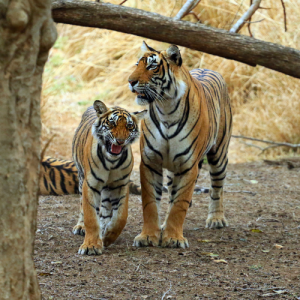
Ranthambore offers a version of New Year’s Eve that feels different from most places. The experience is shaped not by countdowns or music, but by the forest itself. The landscape is a mix of dry deciduous trees, open meadows, and steep cliffs crowned with the walls of the old Ranthambore Fort. Wildlife moves through these spaces at its own pace, and travellers quickly adjust to that rhythm.
Early mornings are the centrepiece. The air is cool, and the forest is active. Safaris set out just after sunrise, when the chances of seeing tigers are highest. Even without sightings, the drive is rewarding — sambar deer grazing in clearings, langurs warming themselves on rocks, peacocks calling from treetops, and owls retreating into hollows. The light is soft, the forest quiet except for bird calls and the sound of tyres on the sandy track.
The rest of the day is intentionally slow. Luxury lodges create a comfortable transition between wilderness and relaxation: long lunches under shade, private decks overlooking waterholes, spa treatments that use local botanicals, or guided nature walks around the lodge periphery. It’s the kind of place where stillness becomes part of the experience — a deliberate pause before the new year begins.
Evenings gather around a fire. There’s conversation, the smell of woodsmoke, and the sound of cicadas. Most luxury lodges host intimate dinners outdoors, where the night is lit softly and the ambience is shaped by the natural surroundings. Midnight is marked quietly — often with a toast under the open sky rather than a formal celebration. The moment is simple but meaningful, shaped by the awareness that the forest continues unchanged around you.
Celebrating the new year here is less about counting down and more about tuning into a landscape that operates on its own logic. For many travellers, that shift — from scheduled to instinctive, loud to quiet — becomes the highlight of the trip.
Planning Tips
- Choose a lodge with strong naturalist teams — the quality of interpretation shapes the entire experience.
- Plan two or more safaris; each drive reveals a different part of the forest, and sightings vary widely.
- Leave time between activities; Ranthambore is best experienced without a full itinerary.
- Request outdoor dining experiences — dinners under the sky are one of the reserve’s highlights.
- Stay at least three nights to balance early safaris with rest and slower moments.
Bandhavgarh, India – Forest, Cliffs, and Solitude 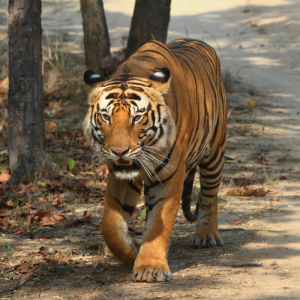
Bandhavgarh offers a more intimate wildlife experience than many larger Indian parks. The landscape is a blend of sal forest, rolling hills, and large meadows framed by sandstone cliffs. For travellers seeking a quieter, more concentrated New Year’s experience, this reserve stands out for its sense of enclosure — you feel held by the terrain rather than surrounded by vast open spaces.
Luxury lodges here emphasise immersion. Mornings begin with soft light pooling through the sal trees and mist rising from shallow valleys. Safaris set out early, moving through narrow forest roads where the chances of hearing — before seeing — wildlife are high. The park is known for tiger density, but the real charm lies in the slower details: the call of the Malabar pied hornbill, the rustle of deer moving through leaf litter, and the sudden stillness that settles when predators are near.
Midday is deliberately unstructured. Many lodges offer shaded courtyards, private pools, or open-air lounges where lunch is served slowly. Naturalists often use this time to share stories of the forest, explain tracking techniques, or highlight the behavioural patterns you might witness during an afternoon drive. For guests who want deeper engagement, some lodges arrange walks outside the core forest zone, focusing on local culture and small-scale conservation projects.
Evening safaris reveal a different atmosphere. The forest warms, shadows lengthen, and animals move toward water sources. Returning to the lodge, guests often gather near a fire for drinks and conversation while the forest hums just beyond the circle of light. New Year’s Eve is typically understated — a special dinner, a quiet toast, and perhaps a late walk along lantern-lit paths. The celebration is shaped not by countdowns but by a sense of calm continuity in the landscape around you.
Planning Tips
- Choose a lodge near the park gates to maximise your time inside the forest.
- Book a mix of morning and afternoon drives; both reveal different animal movements.
- Spend time with naturalists, especially midday — their insight reshapes how you see the forest.
- Stay at least three nights; Bandhavgarh’s pace rewards longer immersion.
- Visit community-run craft or conservation initiatives to understand the region beyond safaris.
Periyar, India – A Forest Connected by Water 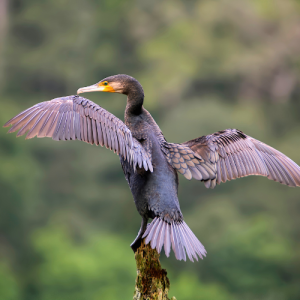
Periyar Wildlife Sanctuary in Kerala offers a very different New Year’s atmosphere — one defined by water, spice-scented air, and a forest that flows gently rather than dramatically. The heart of Periyar is its vast lake, formed by an old dam, whose flooded tree stumps rise like quiet sculptures across the water. Wildlife appears in slow reveals: elephant herds along the banks, Malabar giant squirrels moving through the canopy, and otters surfacing briefly before disappearing again.
Luxury lodges in Periyar focus on sensory immersion rather than visual impact. Mornings begin with boat rides or guided forest walks, each offering a soft, mist-heavy view of the landscape. The emphasis is on listening — to hornbills, to the movement of bamboo, to the calls that echo across the water. This is one of India’s most biodiverse regions, and naturalists often guide guests through layers of plant and bird life rather than chasing big sightings.
Afternoons unfold slowly, often with spa treatments that use cardamom, clove, or cinnamon — a nod to the spice plantations surrounding the reserve. For guests seeking deeper connection, some lodges arrange visits to these plantations, where you can see how spice cultivation, forest life, and local livelihoods intersect.
Evenings in Periyar carry a sense of ease. Lantern-lined paths, quiet dinners overlooking the forest, and the distant sound of nightjar calls make the setting feel removed from usual New Year celebrations. Midnight is marked gently — a toast on a private deck or a walk under a sky unobscured by city lights. The shift into the new year comes through the forest’s calm rather than ceremony.
Planning Tips
- Opt for guided nature walks too; they reveal more than boat rides alone.
- Visit nearby spice plantations for a deeper cultural understanding of the region.
- Choose a lodge with strong sustainability initiatives, as these often provide the best naturalist experiences.
- Plan an afternoon to simply observe the lake — wildlife often appears when you’re still.
- Stay two to three nights to balance activity with rest.
Yala, Sri Lanka – Where Forest Meets Coast 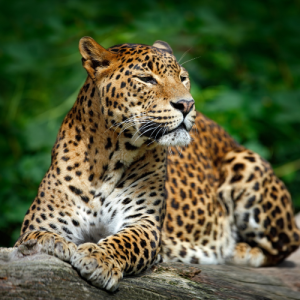
Yala National Park offers one of the most varied landscapes in South Asia — a combination of dry forest, scrubland, wetlands, and a long stretch of coastline. For luxury travellers, it’s a rare opportunity to experience the wilderness on New Year’s Eve in a setting where land and sea meet without interruption.
Safaris here feel expansive. The open terrain allows for broad views, making it possible to see elephants, deer, buffalo, and birds moving across the landscape in clean sightlines. Yala is known for its leopard population, though sightings depend heavily on timing and luck. What stands out more consistently is the sense of scale — long horizons, bright skies, and sudden flashes of wildlife emerging from the scrub.
Luxury camps and lodges elevate the experience without overwhelming it. Many offer tented suites with private decks, ocean breezes, and outdoor showers surrounded by trees. Days revolve around early safaris, long lunches near the beach, and afternoons spent watching waves crash against boulders on the coastline. The combination of forest and ocean creates a rhythm that moves naturally between adventure and rest.
Evenings in Yala have their own character. Fires are lit, seafood is grilled, and the sound of the Indian Ocean becomes the backdrop for the night. New Year’s Eve tends to be intimate — small gatherings, soft music, and a clear sky overhead. Midnight often passes with the sound of waves rather than fireworks. For many travellers, this quiet moment becomes the highlight of the trip.
Planning Tips
- Stay at a lodge with private beach access to experience both forest and coast.
- Book safaris at different times of day; wildlife responds differently to heat and light.
- Leave room for unstructured time — Yala rewards stillness as much as exploration.
- Choose a tented camp if possible; it deepens the sense of being in the landscape.
- Visit between safaris the coastline viewpoints — they are among the park’s best features.
Chitwan, Nepal – A River-Shaped Ecosystem 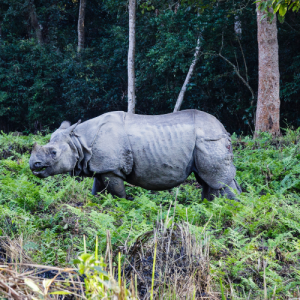
Chitwan National Park in Nepal feels different from other South Asian reserves because of its river-driven landscape. The Rapti River, tall elephant grass, and patches of sal forest create a soft, layered environment — one that encourages patience and close observation rather than fast-paced safaris.
Luxury lodges here focus on quiet immersion. Mornings often begin with canoe rides along the river, drifting past marsh crocodiles warming themselves on sandbanks and birds feeding among reeds. Guided walking safaris offer another perspective, allowing travellers to notice smaller details — footprints pressed into river mud, the scent of sal trees warming in the sun, the collective movement of deer through the grass.
Afternoons are slow by design. Guests often return to shaded verandas overlooking wetlands or grasslands, where rhinos sometimes graze. Naturalists share stories of the Terai region, from cultural practices of the Tharu community to the park’s conservation successes. Many lodges blend wildlife experiences with cultural immersion, offering visits to local villages, traditional dance evenings, or cooking sessions that use ingredients native to the lowlands.
Evenings in Chitwan are calm and atmospheric. Lanterns reflect on the river, insects hum steadily, and the air cools just enough to make outdoor dining comfortable. New Year’s Eve is simple — a shared meal, a quiet toast, and the steady flow of the river nearby. It’s an ideal choice for travellers who want to begin the year in a space where the environment encourages reflection rather than celebration.
Planning Tips
- Try a mix of safari formats — canoe, walk, and jeep — to understand the landscape fully.
- Spend time with local Tharu community guides for cultural depth and regional context.
- Choose a lodge near the river for the best wildlife viewing from your veranda.
- Leave open afternoons — Chitwan’s beauty often emerges during unplanned hours.
- Stay three nights to balance wildlife, culture, and rest.
The Serene Scene: Getaway to a Quiet Start
Pokhara, Nepal – A Lakeside City Below Himalayan Peaks 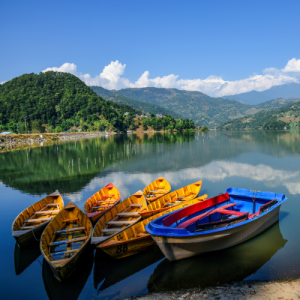
Pokhara offers a gentler introduction to the Himalayas — not through high-altitude treks or remote villages, but through a landscape that feels accessible, spacious, and unhurried. For travellers spending New Year’s Eve in Nepal, it’s one of the most comfortable places to slow down without disconnecting from the world too far.
The city sits beside Phewa Lake, with clear views of the Annapurna range, a major Himalayan massif whose peaks appear surprisingly close on clear mornings. The mountains reflect off the lake in long, calm lines, creating one of the most recognisable vistas in the region. The experience is not about dramatic summits but about the relationship between water and mountain — a scene that shifts with cloud, light, and time of day.
Luxury lodges and boutique hotels are tucked into the hillsides and along the lakeshore. Mornings begin quietly: rowing boats on the lake, paragliders slowly crossing the sky, and soft light spreading across the peaks. Travellers often start their day with a short hike or a slow paddle on the water, both of which offer unobstructed views of the mountains without requiring advanced fitness or long drives.
Afternoons have their own rhythm. Many visitors walk or cycle along the lakeside path, stopping for tea in cafés that open toward the water. Others take the short hike to the World Peace Pagoda, where the view encompasses the entire city and lake. Luxury properties often design unstructured time into the day — long lunches on open terraces, spa treatments using Himalayan botanicals, or quiet hours on private balconies overlooking the lake.
Evenings in Pokhara are calm. Restaurants open their terraces to the cool air, and the lakeshore lights reflect gently across the water. New Year’s Eve celebrations are understated — a shared dinner, soft live music, or a small gathering under the open sky. Midnight might be marked with a few fireworks around the lake, but the emphasis is on atmosphere rather than spectacle.
For travellers seeking a meaningful start to the year, Pokhara offers clarity without intensity. It’s a place where the scale of the Himalayas is always present but never overwhelming — grounding, steady, and easy to settle into.
Planning Tips
- Stay at a lodge with clear mountain views; visibility changes quickly and mornings can be spectacular.
- Start early — the clearest Himalayan views are often just after sunrise.
- Take a slow boat ride rather than a speedboat for uninterrupted lake reflections.
- Visit the Peace Pagoda either at sunrise or late afternoon for balanced light and fewer crowds.
- Plan two unstructured afternoons; Pokhara’s calm emerges in the hours when you’re not doing much.
Sigiriya, Sri Lanka – A Rock Fortress Above the Plains 
Sigiriya is one of Sri Lanka’s most recognisable landscapes — a single rock fortress rising abruptly above forest, farmland, and water gardens. But for travellers spending New Year’s Eve here, the experience is less about the monument itself and more about the quiet patterns of the surrounding countryside.
Luxury lodges sit among palm groves, rice fields, and small lakes. Mornings begin with steady light moving across the plains, birds feeding along the edges of the water, and farmers walking narrow bunds between fields. The climb to Sigiriya Rock at sunrise is the one structured part of the day. The ascent is gradual, and the view from the top places you in the centre of the Cultural Triangle — a wide spread of forest and farmland with occasional white stupas rising above the canopy.
After the climb, the day slows. Many travellers spend the afternoon at their lodge, where open-air restaurants, private plunge pools, and shaded verandas offer long stretches of rest. Naturalists and guides often introduce guests to the area’s ancient hydraulic gardens, explaining how water was channelled through ponds and moats centuries ago. This context adds depth to the landscape without overwhelming the visitor.
Evenings in Sigiriya are calm and spacious. Lanterns light pathways between villas, and the air cools as insects begin their evening chorus. New Year’s Eve celebrations are understated — often a multi-course dinner with local ingredients, followed by casual music or a small gathering around a fire. The night feels anchored not in celebration but in the presence of the rock, visible from many properties as a dark outline against the sky.
Planning Tips – Sigiriya
- Climb early; the light and temperature are most favourable at sunrise.
- Pair your visit with nearby temples or villages to understand how people live around this historic site.
- Spend time in the water gardens — they reveal the engineering brilliance of the region.
- Choose a lodge with open views of the rock; the silhouette becomes part of the stay.
- Stay two to three nights to balance activity with rest.
Punakha, Bhutan – A Valley Defined by Rivers 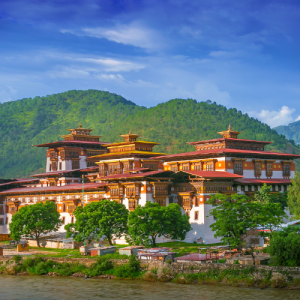
Punakha offers one of Bhutan’s most serene landscapes — a wide valley shaped by the meeting of two rivers, with terraced fields and traditional farmhouses forming the framework of daily life. For luxury travellers spending New Year’s Eve here, the appeal lies in the area’s steady rhythm and its close connection to local culture.
The days start quietly. Morning light spreads across the riverbanks, monks walk between temples, and farmers begin tending to fields that have followed the same patterns for generations. Travellers often visit local monasteries, where morning chants resonate through assembly halls and spill out into courtyards. These visits are not dramatic; they’re grounded, steady, and centred on observation.
Luxury lodges take their cues from the landscape. Large windows frame river views, open-air decks face the mountains, and many properties integrate Bhutanese design into private suites. Time passes slowly: long breakfasts overlooking the valley, guided walks through terraced farmland, and visits to small villages where residents explain seasonal routines and traditional crafts.
In the afternoon, the valley becomes warm enough for gentle hikes or riverside picnics. Many travellers spend time by the water, watching prayer flags shift in the wind or simply following the flow of the river. It’s the kind of place where stillness is not an absence of activity but a natural part of the experience.
New Year’s Eve here is intentionally quiet. Lodges host intimate dinners, sometimes with traditional music or storytelling. Midnight is often marked outside, with a sky filled with stars and the muted sound of the river moving through the valley. The transition into the new year feels grounded — shaped by landscape, culture, and the simplicity of being present.
Planning Tips
- Visit a monastery in the morning to experience the valley at its calmest.
- Choose a lodge with river views, as the landscape shapes the entire stay.
- Spend time walking through farmland; it offers insight into seasonal life.
- Add a short hike to nearby villages or viewpoints for a balanced experience.
- Stay at least two nights to settle into Punakha’s slower rhythm.
Al Hajar Mountains, Oman – A High Plateau With Wide Views 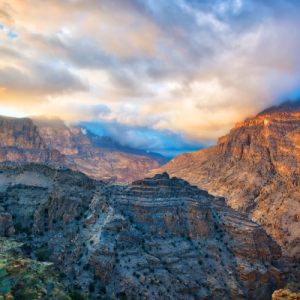
The Al Hajar Mountains rise sharply from Oman’s interior, forming one of the most dramatic and accessible high-altitude landscapes in the region. For travellers seeking a quiet, spacious New Year’s Eve, the range offers an elevated perspective — literally and figuratively.
Luxury lodges sit along the clifftops and plateaus, where views stretch across deep canyons and terraced villages. Mornings begin with cool air and long shadows moving slowly across the rock faces. Travellers often start their day with a guided walk along ancient footpaths used by villagers for generations. These trails reveal terraced farms, small clusters of stone houses, and falaj irrigation channels that have supported life here for centuries.
Afternoons unfold at a slower pace. Many guests choose to sit on wide terraces overlooking the canyon, where the landscape shifts constantly with the light. Some lodges offer spa treatments using regional botanicals, while others arrange private picnics on shaded ledges. The emphasis is on perspective — giving visitors time and space to absorb the scale of the mountains without rush.
As evening approaches, the temperature drops, making outdoor dining comfortable even in winter. Dinners often take place on open decks with clear views of the sky. New Year’s Eve is quiet, with soft music, good food, and a focus on the surroundings rather than performance. Midnight is often marked with a simple toast and the sight of stars spreading across the high-altitude sky.
Planning Tips
- Choose a lodge directly on the cliffs for uninterrupted canyon views.
- Take a guided walk; local trails reveal how people have lived in the mountains for centuries.
- Visit a nearby village to understand traditional architecture and water systems.
- Leave space for slow afternoons — stillness is central to the experience.
- Stay two to three nights for both exploration and rest.
The Solo Scene: Solo Travellers’ Paradise
Kochi, India – A Port City with Layers of Influence 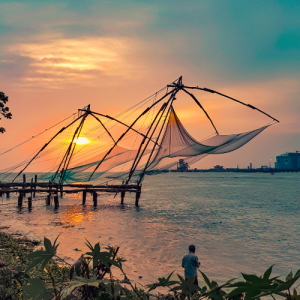
Kochi offers one of the most approachable solo travel experiences in South India, especially around New Year’s Eve. The city has grown around a natural harbour, and this long history of trade shows up in the layers of architecture, food, and daily routines that travellers encounter as they move through its streets. What makes Kochi appealing is not spectacle, but ease — a rhythm that supports both exploration and rest.
The old quarter, Fort Kochi, is compact and walkable. Mornings begin with a steady flow of fishing boats returning to shore, vendors arranging their stalls, and the famous Chinese fishing nets lowering and rising along the waterfront. For travellers, this early part of the day is one of the most rewarding: the light is soft, the air is cooler, and the movement of the harbour gives a clear sense of the city’s character.
Boutique hotels and heritage properties offer quiet courtyards, verandas shaded by trees, and rooms designed around local materials. Breakfasts often stretch into mid-morning, with guests lingering over coastal dishes and freshly brewed coffee. Afterward, the day unfolds at a gentle pace. Travellers often walk or cycle between art galleries, spice shops, and cafés — many run by local artists or families, each with its own perspective on Kochi’s cultural mix.
Afternoons can be spent exploring the backwaters on a guided canoe or small boat ride. These excursions move through narrow canals lined with tropical vegetation, small homes, and village pathways. The experience is calm and observational — a contrast to the busier waterfront streets. For travellers who prefer staying in the city, the forts, synagogues, and historic churches offer a well-preserved view of Kochi’s layered past.
Evenings gather slowly. Restaurants open their terraces to the sea breeze, and travellers often choose places where they can watch the harbour empty and refill as boats shift with the tide. New Year’s Eve here is relaxed: modest fireworks, live music in small cafés, and dinners that stretch into the night without a set programme. It’s a celebration shaped more by atmosphere than by scale.
For solo travellers, Kochi feels welcoming without being curated. Conversations spark easily, movement is straightforward, and the city’s slower pace makes it easy to build a day that balances cultural exploration with quiet time.
Planning Tips
- Stay in Fort Kochi for easy walking access to heritage sites, cafés, and the waterfront.
- Explore early in the day — the light, temperature, and harbour activity make mornings the most rewarding.
- Take a guided backwater trip for a deeper look at daily life beyond the city.
- Visit during the afternoon lull to enjoy quieter galleries and streets.
- Plan at least one unstructured day to simply wander — Kochi reveals itself gradually.
Jaipur, India – Craft Traditions in an Urban Setting 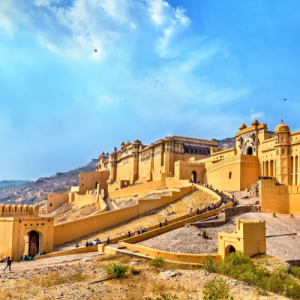
Jaipur offers solo travellers a balance between cultural depth and ease of movement. The city’s historic core is defined by craft traditions that continue to shape everyday life — block printing, gemstone setting, metalwork, and textiles. For travellers, this means the most meaningful experiences come not from sightseeing, but from stepping into the places where these crafts are practiced.
Mornings in Jaipur are ideal for exploration. The air is cooler, and artisans begin their day early. Workshops open their doors to visitors, allowing travellers to observe the process behind the city’s famous block-printed fabrics or see jewellers shaping and polishing stones. Many boutique hotels arrange guided visits to these studios, which offer insight into the skill and precision of the local craft economy.
Afternoons slow down. Courtyards fill with filtered light, and rooftop cafés provide shaded spaces to rest. Travellers often spend this time browsing small design stores or visiting museums that showcase Rajasthan’s textile and artistic heritage. For those interested in photography or quiet observation, the city’s pink buildings and market lanes offer constant movement without overwhelming pace.
Evenings in Jaipur feel warm and open. Rooftop restaurants offer wide views of the city, and many travellers choose to end the day here with a meal that features regional Rajasthani flavours. New Year’s Eve tends to be relaxed — small gatherings, live folk music, and dinners that lean toward intimate rather than loud. Fireworks are visible in the distance, but the city’s charm lies more in its steady rhythm than in spectacle.
Planning Tips
- Begin early in the day to see artisans at work before the markets get crowded.
- Choose heritage hotels or boutique stays for stronger cultural context.
- Visit craft workshops to understand the skill behind Jaipur’s design economy.
- Select a rooftop restaurant for sunset views and a quieter New Year’s Eve.
- Stay two to three nights to explore without rushing.
Chennai, India – A City That Begins at the Shore 
Chennai is one of South India’s most grounded coastal cities, and its connection to the sea shapes how travellers experience it. The day begins at Marina Beach, where runners, walkers, fishers, and vendors share the same long stretch of sand. For solo travellers, this early-morning scene is one of the easiest ways to understand the city — open, active, and communal.
Luxury hotels often sit close to the water, offering easy access to the shoreline and quiet, shaded terraces for breakfast. Afterward, many travellers explore Mylapore, a neighbourhood known for its temples, narrow lanes, and classical music traditions. The rituals around the temples and the movement of local residents provide a grounded sense of everyday life.
Afternoons in Chennai lend themselves to slow exploration: visiting bookstores, stopping at filter-coffee cafés, or browsing contemporary design studios. The city’s cultural institutions — particularly music academies and art galleries — offer a rich look at South India’s artistic heritage. For travellers interested in performance, the December–January period often coincides with the Carnatic music season, making it one of the best times to hear traditional concerts.
Evenings return to the sea. Many travellers choose restaurants overlooking the coast or seek out small venues with live music. New Year’s Eve in Chennai tends to lean toward relaxed celebrations rather than large-scale events — quiet dinners, ocean breezes, and a few small fireworks along the beach.
Planning Tips – Chennai
- Start at Marina Beach to understand the city’s daily rhythm.
- Explore Mylapore in the morning when temple rituals are active.
- Attend a Carnatic music performance if visiting in December–January.
- Try local filter coffee from neighbourhood cafés.
- Choose a stay near the shoreline for easy access to the city’s most defining landscape.
Colombo, Sri Lanka – A Coastal Capital With Room to Wander 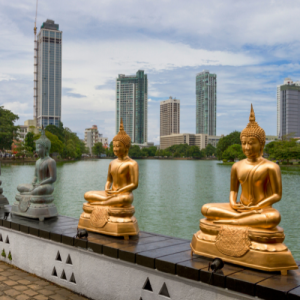
Colombo is a city built around movement — along the coast, through leafy residential areas, and between markets that open and close with the rhythm of the day. For solo travellers spending New Year’s in Sri Lanka, it offers a mix of structure and spontaneity that’s easy to navigate.
Mornings are particularly calm along the Galle Face Green promenade, where walkers and joggers move alongside the waves. The air is cool, the city is just waking, and the coastline provides a clear view of Colombo’s mix of heritage buildings and modern design. Luxury hotels here offer breakfast terraces with uninterrupted ocean views, making it an ideal start to the day.
During the afternoon, travellers explore neighbourhoods that each tell a different story — the Fort area with its colonial architecture, Pettah with its market rhythms, or Cinnamon Gardens with its tree-lined streets and quiet cafés. Colombo’s art galleries and small museums offer a deeper look at the country’s history, contemporary art, and changing urban identity.
Evenings settle comfortably along the waterfront. Restaurants open their terraces to the sea breeze, and travellers often choose places where they can watch the sky change colour. New Year’s Eve brings modest fireworks, small concerts, and gatherings that feel local and relaxed. The city avoids overwhelming scale, making it easy for solo travellers to move between venues or simply stay in a single spot for the night.
Planning Tips
- Begin on the Galle Face promenade to see the city at its calmest.
- Explore one neighbourhood at a time to avoid rushing.
- Visit galleries and museums for historical and contemporary context.
- Choose coastal restaurants for a relaxed New Year’s dinner.
- Stay near the water to make walking and exploring easier.
Kathmandu, Nepal – A City Where Ritual and Daily Life Overlap 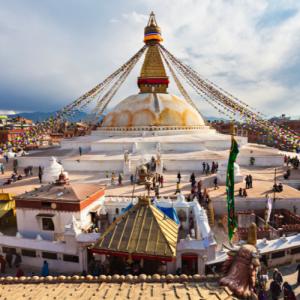
Kathmandu offers a blend of movement and stillness that becomes especially clear to solo travellers. The city’s old quarters are dense with temples, shrines, and courtyards, each carrying its own rhythm. What stands out is not spectacle but continuity — daily rituals unfolding alongside modern life.
Mornings in Kathmandu are shaped by activity around Boudhanath Stupa and the narrow lanes around Patan. Residents walk kora — a clockwise circumambulation — turning prayer wheels as they pass. Shopkeepers open their stores, incense drifts upward, and pigeons move across the rooftops in sudden bursts. For travellers, this early window offers the clearest sense of how the city begins each day.
Boutique hotels and converted heritage houses offer shaded courtyards, rooftop terraces, and quiet rooms set away from the main streets. After breakfast, travellers often explore the artisan quarters of Patan, where metalworkers, woodcarvers, and painters continue centuries-old traditions. Watching these processes firsthand adds context to the city’s cultural depth without requiring formal tours.
Afternoons are ideal for slower movement — sitting in a tea house, visiting contemporary art galleries, or exploring minor temples where residents gather informally. Kathmandu’s energy is steady, not rushed, making it one of the easiest South Asian cities for solo travellers to navigate at their own pace.
New Year’s Eve is modest: a few small gatherings, rooftop dinners, and occasional fireworks above the valley. The celebration feels rooted rather than staged, shaped by local routine more than imported trends.
Planning Tips
- Visit Boudhanath early to experience the city’s daily rhythm.
- Spend time in Patan’s artisan quarter to see traditional crafts alive in real time.
- Choose accommodation with a courtyard or rooftop for quiet breaks.
- Move slowly through neighbourhoods; Kathmandu reveals itself in details.
The new year can begin in a skyline lit by fireworks, in a forest just before dawn, or beside a river that moves at its own pace. What matters is the moment when you feel awake to the world around you.
Explore our journey ideas to find the place where your next beginning waits.

